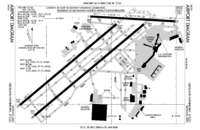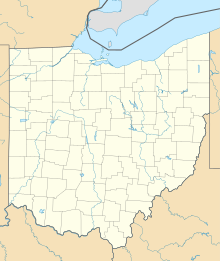Cleveland Hopkins International Airport
| Cleveland Hopkins International Airport |
|||||||||||||||||||
|---|---|---|---|---|---|---|---|---|---|---|---|---|---|---|---|---|---|---|---|
 |
|||||||||||||||||||
 |
|||||||||||||||||||
| Summary | |||||||||||||||||||
| Airport type | Public | ||||||||||||||||||
| Owner | City of Cleveland | ||||||||||||||||||
| Operator | Cleveland Airport System | ||||||||||||||||||
| Serves | Cleveland, Ohio, U.S. | ||||||||||||||||||
| Location | Cleveland, Ohio, U.S. | ||||||||||||||||||
| Focus city for | Frontier Airlines | ||||||||||||||||||
| Elevation AMSL | 791 ft / 241 m | ||||||||||||||||||
| Coordinates | 41°24′42″N 081°50′59″W / 41.41167°N 81.84972°WCoordinates: 41°24′42″N 081°50′59″W / 41.41167°N 81.84972°W | ||||||||||||||||||
| Website | www |
||||||||||||||||||
| Maps | |||||||||||||||||||
 FAA airport diagram |
|||||||||||||||||||
| Location of airport in Ohio/United States | |||||||||||||||||||
| Runways | |||||||||||||||||||
|
|||||||||||||||||||
| Statistics (2015/2016) | |||||||||||||||||||
|
|||||||||||||||||||
|
Source: Federal Aviation Administration and CLE airport.
|
|||||||||||||||||||
| Aircraft operations (2016) | 119,268 |
|---|---|
| Total passengers (2015) | 8,100,073 |
Cleveland Hopkins International Airport (IATA: CLE, ICAO: KCLE, FAA LID: CLE) is a public airport located nine miles (14 km) southwest of the central business district of Cleveland, Cuyahoga County, Ohio, United States. It is the primary airport serving Northeast Ohio and is the largest and busiest airport in the state of Ohio. The metropolitan area is also served by Burke Lakefront Airport and by Akron-Canton Regional Airport. Cleveland Hopkins International Airport and Cleveland Burke Lakefront Airport together comprise the Cleveland Airport System, operated by the City of Cleveland's Department of Port Control.
The airport is of particular importance to the history of commercial air travel due to a number of first-in-the-world innovations that would eventually become standard around the globe. Founded in 1925, it was the first municipality-owned facility of its kind in the United States. It was the site of the first air traffic control tower, the first ground-to-air radio control system, and the first airfield lighting system, all in 1930; and it was the first U.S. airport to be directly connected to a local or regional rail transit system, in 1968. It was also the first airport to employ a two-level terminal design separating arrivals from departures.
The airport was named after its founder, former city manager William R. Hopkins, on his 82nd birthday in 1951.
...
Wikipedia


